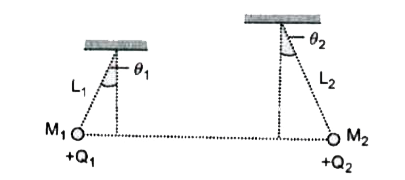The K.E. of the electron is E, when the incident wavelength is λ. To increase the K.E. of the electron to 2E, the incident wavelength must be : Solution in Kannada
hcEλ−hc
hcλEλ+hc
hλEλ+hc
hcλEλ−hc
The correct Answer is:B
hcλ=hv0+Eandhcx=hv0+2E
orhcλ−E=hcx−2E, Solving x=hcλλ+hc
Topper's Solved these Questions
- ELECTRONS & PHOTONSBOOK - MODERN PUBLICATIONCHAPTER - ELECTRONS & PHOTONSEXERCISE - MULTIPLE CHOICE QUESTIONS (LEVEL-III)
9 Videos
- ELECTRONS & PHOTONSBOOK - MODERN PUBLICATIONCHAPTER - ELECTRONS & PHOTONSEXERCISE - RECENT COMPETITIVE QUESTIONS
20 Videos
- ELECTRONS & PHOTONSBOOK - MODERN PUBLICATIONCHAPTER - ELECTRONS & PHOTONSEXERCISE - RECENT COMPETITIVE QUESTIONS
20 Videos
- ELECTROMAGNETIC WAVESBOOK - MODERN PUBLICATIONCHAPTER - ELECTROMAGNETIC WAVESEXERCISE - RECENT COMPETITIVE QUESTIONS
4 Videos
- ELECTROSTATICSBOOK - MODERN PUBLICATIONCHAPTER - ELECTROSTATICSEXERCISE - RECENT COMPETITIVE QUESTIONS
39 Videos
Similar Questions
Energy required for the electron excitation in Li++ from the first to the third Bohr orbit is :
View SolutionAccording to Einstein's photoelectric equation the graph of K.E. of the photoelectron emitted from the metal versus the frequency of the incident radiation gives a straight line graph whose slope
View SolutionAccording to Einstein's photoelectric equation the graph of K.E. of the photoelectron emitted from the metal versus the frequency of the incident radiation gives a straight line graph whose slope
View SolutionThe speed of electromagnetic wave in vacuum depends upon the source of radiation
View SolutionTwo small spheres of masses M1andM2 are suspended by weightless insulating threads of lengths L1andL2 The spheres carry charges Q1andq2 respectively . The spheres are suspended such that they are in level with one another and the threads are inclined to the vertical at angles of θ1andθ2 as shown . Which one o fthe following conditions , if θ1=θ2 ?

View SolutionThe kinetic energy of an electron is E when the incident wavelength is lamda To increase ti KE of the electron to 2E, the incident wavelength must be
View SolutionThe KE of the photoelectrons is E when the incident wavelength is (lamda)/(2) . The KE becomes 2E when the incident wavelength is (lamda)/(3) . The work function of the metal is
View SolutionElectrons are emitted from the cathode of a photocell of negligible work function, when photons of wavelength lamda are incident on it. Derive the expression for the de Broglie wavelength of the electrons emitted in terms of the wavelength of the incident light
View SolutionLight of wavelength 300 Å in Photoelectric effect gives electron of max. K.E. 0.5 eV. If wavelength change to 2000 Å then max. K.E. of emitted electrons will be
View SolutionK.E of photon electrons is E. When light of wavelength,λ falls on them.If K.E of photon electrons reduces to half i.e.E2, then,wavelength of incident light will be ..
View SolutionWhen incident wavelength is λ, stopping potential is 3V0. If incident wavelength is 2λ then stopping potential is V0. Find out threshold wavelength in terms of λ.
View SolutionK.E. of photo electron is E when incident frequency is lambda_(1) . It is 2E when incident frequency is lambda_(2) . The relation between the wavelength is
View SolutionThe K.E. of the most energetic electrons emitted from a metallic surface is doubled when the wavelength, λ of the incident radiation is reduced from 400 nm to 310 nm. The work function of the metal is
View SolutionElectrons are emitted from the cathode of a photocell of negligible work function, when photons of wavelength λ are incident on it. Derive the expression for the de Broglie wavelength of the electrons emitted in terms of the wavelength of the incident light
View SolutionThe K.E of the electron is E when the incident wavelength is λ. To increase the K.E of the electron to 2E, the incident wavelength must be
View Solution
